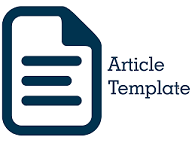The Relationship Between Class Climate And Citizen’ Participation In Learning Equality Package B in SPNF-SKB Region II Padang City
Abstract
The background to this research is the low participation of residents in the package B equality learning program at SPNF-SKB Region II Padang City. One of the suspected causes is that classroom conditions are less conducive for residents taking part in the program. The aim of this research is to see an overview of the classroom climate in package B equality learning at SPNF-SKB Region II Padang City. We also want to see a picture of student participation in package B equality. Apart from that, we want to know the relationship between classroom climate and learning participation in package B equality in SPNF-SKB Region II Padang City. In this research, a quantitative approach was used to carry out correlational analysis. In this research, the population studied was 72 people who were citizens studying package B equality in SPNF-SKB Region II Padang City. At the same time, the sampling technique used was stratified random sampling with a proportion of 50% (36). Data collection technique employs the distribution of questionnaires directly to the respondents. Percentage and product moment formulas are used in data analysis techniques. From the research conducted, it was found that the classroom conditions of students who used package B in studying equality were classified as unsupportive, and citizen participation in studying equality in package B tended to be low. Apart from that, there is a significant relationship between class conditions and student participation in package B equality learning at SPNF-SKB Region II Padang City. Tutor research findings suggest that the class atmosphere in Package B learning can be improved.
Keywords: Clasroom Clite,, Participation, Learning Cittiziens
Full Text:
PDFReferences
Alfiyan, D. (2019). HUBUNGAN ANTARA PERSEPSI PESERTA DALAM MENGIKUTI DIKLATSAR DI KSR PMI UNIT. 2005. https://doi.org/10.24036/spektrumpls.v1i3.9510
Arikunto,S. (2016). Prosedur Penelitian: Suatu Pendekatan Praktik. Jakarta: Rineka Cipta
Dewi, M. Y., Ulfah, M., & Matsum, J. H. (2019). Analisis Faktor Yang Mempengaruhi Partisipasi Peserta Didik Dalam Pembelajaran Akuntansi. FKIP Untan Pontianak, 1–9.
Efendi, D., & Ismaniar, I. (2021). Correlation Between Interest With Participation of Toddlers Mothers in the Activities of the Posyandu. SPEKTRUM: Jurnal Pendidikan Luar Sekolah (PLS), 9(3), 438. https://doi.org/10.24036/spektrumpls.v9i3.113796
Hadiyanto. (2016). Teori dan Pegembangan Iklim Kelas dan Iklim Sekolah. November, 1–85.
Karimah, N., Industri, D., & Karimah, N. (2023). EKSISTENSI PENDIDIKAN NON FORMAL DAERAH INDUSTRI ( STUDI FENOMENA TPQ AL-AMIN BAMBE DRIYOREJO ). 2(2), 65–71.
Solfema.(2021). STATISTIKA PENDIDIKAN. Kencana
Sugiyono. (2017). Metode Penelitian Kuantitatif, Kualitatif, dan R&D. Jakarta: Alfabeta
Taniredja T. (2013). Model-model Pembelajaran Inovatif dan Efektif. Bandung. AlfaBeta.
Wahyuni, Z., & Wisroni, W. (2021). Relationship Between Climate Class and The Learning Outcomes of Light Vehicle Engineering Training Participants in The Padang Jobs Training House. SPEKTRUM: Jurnal Pendidikan Luar Sekolah (PLS), 9(2), 178. https://doi.org/10.24036/spektrumpls.v9i2.112266
Widoyoko, S.E.P. (2014). Evaluasi Program Pembelajaran: Panduan Praktis bagi Pendidik dan Calon Pendidik. Yogyakarta: Pustaka Belajar.
DOI: https://doi.org/10.24036/kolokium.v11i3.689
Refbacks
- There are currently no refbacks.

This work is licensed under a Creative Commons Attribution 4.0 International License.

